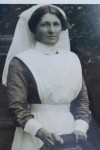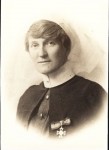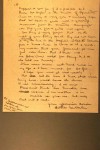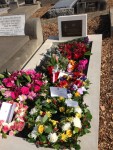LEE-ARCHER, Estelle Frances
Estelle Frances Lee-Archer (1879-1960) was born in Detention, Tasmania, the eleventh of fourteen children born to John Lee-Archer and his wife Mary Anne (nee Lyons).
John Lee-Archer (1842-1907) was a second generation Tasmanian, a son of the distinguished colonial architect and civil engineer of the same name. John senior had designed numerous significant public buildings in Tasmania, and subsequently held prominent government positions in the district of Horton in the northwest of the colony. The family lived in Stanley. (Anne Lee-Archer, Archer, John Lee, Biographical Dictionary of Civil Engineers in Great Britain and Ireland Vol 3 1830-90, pp. 21-22). The younger John married Irish-born Mary Anne Lyons (1842-1901), who had emigrated with her family and lived in the Stanley district. Mary Anne's nephew Joseph, also brought up in the Stanley area, was Prime Minister of Australia from 1932 to 1939.
John's family was Church of England; Mary Ann's was Roman Catholic. The marriage ceremony was conducted in 1864 by the popular Catholic priest at Stanley and publicised in several Tasmanian papers. The young newly weds moved across Bass Strait to Victoria. Their first two children were born in Melbourne in 1865 and 1866, the next three in Kyneton (a town of around 3 000 people), and the next four in Melbourne. Four of these nine children died before their first birthday.
Around 1875 the couple returned to the Horton district in northwest Tasmania where they had both been brought up. John farmed land around Rocky Cape, and prospected for copper. Their remaining children were all born in the district.
Estelle Frances was born on 2 January 1879. Virtually nothing is known of her early life beyond the death of her youngest brother aged 2 months in 1885, and the fact that she applied for a teaching position with the Education Department in Tasmania in 1898.
In 1901 and 1902, Estelle and her family faced several upheavals. Her mother Mary Anne died in March 1901. She had borne at least fourteen children over a twenty year period. Fifteen months later, widower John Lee-Archer married Lillian Margaret Brumby of Longford. Lillian was 30, half his age and younger than his oldest daughter. A few weeks after the wedding, Estelle's brother Leslie drowned following an accident on the ketch on which he worked.
Estelle's young stepmother Lillian bore John Lee-Archer five children (including a set of twins) between 1903 and 1907. Then The family faced more sadness when John died in April 1907. Seriously ill, he had travelled to Melbourne for medical advice and possible surgery, but died of cancer two weeks later (John Lee Archer, Inquest 1907/243, Public Records Office of Victoria; Bendigo Advertiser, 24.4.1907, p.5).
Estelle and several siblings had previously moved to Melbourne. Around 1909, she began training as a nurse at the Alfred Hospital in Prahran. She completed the three year program and passed the examinations for the Royal Victorian Trained Nurses Association in mid 1912. She seems to have been the first in her immediate family to be a nurse.
War Service
After qualifying as a nurse, Estelle worked at two hospitals, both in East Melbourne. The first was Mena House Private Hospital, located at 29 Simpson St, which specialised in obstetrics and gynaecology. She lived nearby, at Crathie at 118 Gipps St, which at the time functioned as a boarding house.
In 1914, Crathie itself became a private hospital, owned and operated by Mrs Jessie McHardy White, and Estelle began working there. Among her various commitments, Mrs McHardy White was a senior member of the Australian Army Nursing Service Reserve. She was one of the first six nurses selected for overseas service after war broke out, leaving Melbourne for Egypt in October 1914. It is not surprising that some of McHardy White's nurses at Crathie were inspired to follow her and at least three did, Minnie Hobler, Jessie Gemmell and Estelle Lee-Archer.
Estelle enlisted on 5 October 1914. She was and remained the first and only member of her immediate family to enlist in the Great War.
She sailed from Melbourne with the 1 Australian General Hospital on the 'Kyarra' on 28 November 1914 with 160 other nurses and medical officers who made up the 1 and 2 Australian General Hospitals. The Royal Victorian Trained Nurses Association gave them a fine farewell (Punch, 26.11.1914). There were other nurses from East Melbourne in the group, including Minnie Hobler. The seven week voyage with its seasickness, lectures and deckgames was recorded in the diary of Staff Nurse Elsie Cook (Peter Rees, The Other ANZACs: Nurses at War, 1914-1918, pp. 7-11, 15).
'Kyarra' reached Egypt on 20 January 1915. 1AGH was set up in the Heliopolis Palace Hotel, a four story luxury facility in the Cairo suburb of Abbassia.
Estelle Lee-Archer’s period at 1AGH was a time of near continuous high drama. The deluge of casualties evacuated from the Gallipoli peninsula placed enormous physical and emotional demands on the nursing staff which was expanded with reinforcements as the number of beds expanded (see Rees, The Other ANZACS, pp. 44-45, 48-49). In addition, there was the battle for authority between Principal Matron Jane Bell and 1AGH Commanding Officer Colonel Ramsay Smith that led to the recall of both to Australia in July 1915, a formal inquiry and termination of their appointments (Jan Bassett, Guns and Brooches: Australian Army Nursing from the Boer War to the Gulf War, 1992, pp. 34-39).
Estelle was awarded the Royal Red Cross (2nd Class) for her ‘conspicuous services’ while attached to 1 AGH. She was also promoted from staff nurse to sister.
No 1AGH was reorganised in August 1915. Lee-Archer was posted to England where her former Crathie matron McHardy White was in charge of AANS nurses. Lee-Archer worked for six months at Bagthorpe Military Hospital in Nottingham (Nov 1915-May 1916). While there, she was ill for some weeks, afflicted first with conjunctivitis and then fainting spells - spectacles, a tonic and rest were prescribed. She then nursed at Coulter Hospital (May-September 1916), a converted private house in Grosvenor Square, London. Treating mainly officers, Coulter was much smaller and more intimate than Bagthorpe. It had an Australian feel, with Australians among the patients, medical officers and nurses (Coulter Hospital, Lost Hospitals of London, http://ezitis.myzen.co.uk/coulter.html). During this period she was invested with the Royal Red Cross decoration by King George V at Buckingham Palace.
In September 1916, Estelle was sent to the new 2 Australian Auxiliary Hospital in Southall, London, and with the exception of a short stint at the 1 New Zealand General Hospital at Brokenhurst and leave, she worked there for seven months. Located in two schools, 2AAH started as a clearing hospital but quickly specialised in fitting artificial limbs, mainly legs. With nearly 500 beds it was busy, admitting nearly 9000 patients and performing 600 operations in its first year (1AAH, War Diary, AWM).
In April 1917, Estelle was sent to France. Between then and August 1918, she worked in eight hospitals and two casualty clearing stations as nurses were moved to places of need in the constantly changing war situation.
From June to September 1917, she was with the 3 Australian General Hospital which had just moved to Abbeville. Led by Matron Grace Wilson, 3AGH had 1500 beds, medical officers and 90 sisters. They were soon inundated with sick and wounded troops direct from the front, usually several hundred at a time.
3AGH also provided teams of surgeons and nurses for casualty clearing stations, and Estelle was sent for duty in two (47CCS and 3ACCS) in the autumn of 1917. The work was hard, dealing with dreadfully wounded men brought straight from the front and a high number of deaths. It was also dangerous because the stations themselves came under fire. Sister May Tilton served in 3ACCS at the same time as Estelle and described the wounded and the nursing in graphic detail in her diary later published as The Grey Battalion (1933); see extracts at theselines.com.au/research/3-ACCS):
'The advance up the line resulted in a heavy toll of victims, and patients were admitted before the hospital was properly equipped and ready. It was pouring with rain, making conditions bad for the men in the line, and worse for the wounded who lay out in it, sometimes for days.
Patients began to arrive at 11 a.m., and in the first twenty-four hours about three thousand patients passed through our C.C.S. We admitted for twenty-four hours at a time in turn with the other C.C.S. alongside us. Hospital trains stood by and carried the wounded away as fast as we could get them ready. Only the worst cases could we possibly hope to attend to.
The work in the Resuscitation ward was indescribable. The butchery of these precious lives— men of such splendid physique! To watch them dying in such numbers was ghastly. Their frightful condition was appalling.'
Estelle succumbed to an unspecified illness in November and was off-duty until early January 1918. She returned to 3AGH in Abbeville where there was relative comfort and calm at least in January and February. In March, the pressure of numbers and nature of the cases arriving at 3AGH meant she was working in CCS-type conditions again with many of the sick and wounded arriving straight from the battle field with only field dressings.
In April, nursing numbers at 3AGH were significantly reduced. Estelle was among the sisters sent to Boulogne, 80 kilometres from Abbeville, where she worked at 7 Stationary Hospital. She was then sent to Rouen, to 25 General Hospital and the 2 Australian General Hospital.
In August she returned to 3AGH, her fourth hospital in four months. 3AGH itself suddenly became like a CCS again, with convoys of severely wounded troops arriving by ambulance train. Matron Miles-Walker described the scene in her report in the war diary: ‘all being stretcher cases with large wounds – penetrating Abdomen and Chest cases and Head wounds, also a large number of amputations’.
The health of the nurses, she reported, was good. In fact, Estelle Lee-Archer was not well. On 27 August she went to England on leave, where she was declared ‘medically unfit for service in France’ (Lee-Archer, Service Record). She spent several weeks in hospital. The 3AGH matron noted in her report the following month that ‘One Sister was detained in England on completion of her leave for health reasons’.
For the remaining months of the war, Estelle rotated between the three Australian Auxiliary Hospitals in Dartford (3AAH), Harefield (1AAH) and Southall (2AAH), where the patients were Australian troops being treated in readiness for repatriation back to Australia.
After the War
By the time the war ended, Estelle had been out of Australia on active service for four long and continuous years. She had had no return journey to Australia on a hospital or transport ship, nor a respite period of home service despite several bouts of ill-health. She took her entitlement of 10 weeks long service leave in the winter of 1918-19, though there is no record of how or where she spent it.
She returned to Australia on the 'Kildonan Castle' in March 1919.
Like many returned army nurses, Estelle worked in military or repatriation hospitals in the 1920s and 1930s, in her case at No 11 Army General Hospital/Caulfield Repatriation. The military hospital became a civilian hospital under the authority of the Repatriation Commission in 1921. With the change, 'the doctors and nurses patiently cared for the residue [of patients], too disabled or ill to return the real world. It had become a hospice for the incurable and the unwanted' (Bruce Ford, The Wounded Warrior and Rehabilitation, including the history of No 11 Army General Hospital/Caulfield Rehabilitation Hospital, 1996, p.83).
In 1925, Estelle sailed again for England, travelling 3rd class on SS Goorkha, an old mail steamer that had been a hospital ship in the war. The ship called in at Mauritius and Durban before arriving in London on 31 May. She understated her age by 6 years, giving it as 39. Her proposed address was St George's Home, Vincent Square (in a hospital precinct) and she intended to be there at least a year. She was keen to return to ‘some of the old haunts during the War’. Employed to care for an invalid traveller she visited many tourist locations in Europe. She returned to Australia eighteen months later in First Class, presumably with the same patient or another, this time travelling 1st class on the Orient Line's Otranto. (UNA, Victorian Trained Nurses Association, vol XXIII (3), 1 May 1925, vol XXIV (9), 1.11.1926, p239; UK, Incoming Passenger Lists 1878-1980; Outward Passenger Lists 1890-1960).
Estelle returned to Caulfield Hospital, working at least some of the time in a temporary capacity. She also drew a war pension for 'debility and DAH' (fatigue and 'disordered action of the heart').
On 2 November 1936, before her final shift on night duty she fell at home and broke her femur. Surgery did further damage which required more operations and months of hospitalisation. She sought compensation from the Repatriation Commission (technically her employer) but her claim was rejected. In desperation she turned to her cousin, Joe Lyons, the Prime Minister of Australia, and implored him to intervene on her behalf. He pursued the matter assiduously through the Ministers for Repatriation, the Commission and his own office, and he updated Estelle regularly and reassuringly (NAA, CP167/2/16). The Returned Sailors and Soldiers Imperial League of Australia took up her cause. Unfortunately, contradictions in her account and the fact that she was not at work when she fell meant her claim was never successful.
In anguished letters to her cousin Joe written from her bed (preserved in the Prime Minister’s correspondence), Estelle implored him to visit. The doctors said she would not nurse again: 'I really don't know what I am going to do', she wrote from St Vincent's Hospital (28.6.1938). Several times, she said, she thought she would die. She was dismayed at her treatment by the nursing staff, whom she said were no friends of the Lyons government. That others with far less war service than her four and a years 'get much more recognition' was galling to her (23.5.1938).
'I have never known such hard nurses in my life, and I have nursed for 25 yrs ... the tears I have shed since being here would cause the Yarra to rise considerably I'm sure. Please don't think I am neurotic nor insane. I am neither and as sensible as you are but only tired out and sad. Your affectionate cousin ... (9.11.1937)'
In July 1938 she informed Joe she was out of hospital but 'still in bed cannot walk' (25.7.1938).
According to electoral rolls from the 1920s to the 1950s, Estelle lived at times at or near Caulfield Hospital, and also in Middle Park, Albert Park and Ripponlea, presumably in flats. In 1956, she was pictured with other returned army nurses at the sod turning for the new hostel for returned nurses and service women in St Kilda, Melbourne (UNA, Victorian Trained Nurses Association, vol LIV (7), July 1956, p198).
Despite her war service and disability, Estelle outlived all her brothers and sisters. She died in the Heidelberg Repatriation Hospital in Melbourne on 24 April 1960 and was buried in the Cheltenham General Cemetery.
Estelle Lee-Archer's grave lay unfinished and unmarked for over 50 years. Her service medals and the Royal Red Cross decoration pinned on her by George V were lost. In 2013, after concerted lobbying of the Commonwealth Government by Margaret Leyden, Louise Lee-Archer, Margaret Hattersley and others, Estelle's grave was restored amid considerable ceremony and interest. Her decoration and medals were also recovered and are held in the Maryborough Military and Colonial Museum in Queensland.
Sincere thanks to Louise Lee-Archer and Margaret Leyden for information and photographs.
Louise Lee-Archer, "Estelle Frances Lee-Archer ARRC" (2013). Copy held by the East Melbourne Historical Society.
Janet Scarfe
Adjunct Research Associate, Monash
29 January 2017





